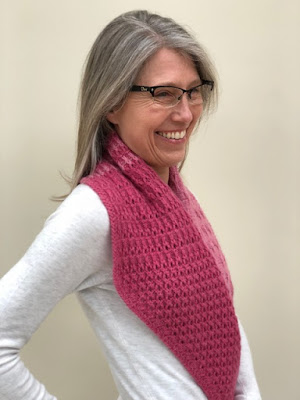 |
| Graffiti (https://www.ravelry.com/ |
Once a week I post interviews with interesting people about their insights on their experience of working in the Knitting industry. I’ve noticed that every one of these individuals makes their living in a slightly different manner bringing their own unique presence to the knitting world.
You can find Paola here on Ravelry.
 |
Antinebbia (https://www.ravelry.com/
|
Where
do you find inspiration?
I
have two main sources of inspiration, depending on
whether
I'm working on an accessory or on a garment.
In accessories, I am mostly inspired by contemporary abstract art. This is particularly true when we speak about shawls, which I imagine as wearable paintings made with yarn. I love seeing color, harmony and shapes in pictures, paintings, street art and graffiti, and I try to convey this kind of inspiration in my patterns.
In accessories, I am mostly inspired by contemporary abstract art. This is particularly true when we speak about shawls, which I imagine as wearable paintings made with yarn. I love seeing color, harmony and shapes in pictures, paintings, street art and graffiti, and I try to convey this kind of inspiration in my patterns.
When
I'm working on garments, I'm interested in wearability for
-
I confess! -
my body shape. I have a sewing background, and I love
translating sewing model making into knitting:
it poses
a lot of geometric/math problems that I like to solve, it's like
playing with puzzles!
In
both cases, I love unconventional and unusual constructions, bright
colors and strong contrasts.
I
am by no means a minimalist, I want my creations to be noticed,
because they are different from anything you can buy in a shop.
What is your favourite knitting technique?
When
following others' designs, I love every technique. Cable, lace,
colorwork, you name it!
When
designing I'd say that short rows, modular knitting, and brioche (not
necessarily in this order) are the techniques that I use more often
and that I feel more natural to me.
 |
| Gocce (https://www.ravelry.com/ |
Do you look at other designers’ work or are you afraid that you will be influenced by their designs?
I
think that it
is simply impossible not to look at other designers' work!
I
try to follow what's going on in the knitting world, with the
intention of
excluding
the ideas
that have been already "used" by others.
How many sample/test knitters do you have working for you or do you do it all yourself?
I
knit my samples myself, because I like the process and because I
often change my mind on some details (and yes, sometimes on the
entire construction!) while knitting. I know that this is slowing
down my productivity, but I enjoy this freedom so much!
I
use as many test knitters I can,
to be sure that my patterns are correct. I know many say that a tech
editor is enough, but I am a former software developer and I cannot
even think that an algorithm (a knitting pattern can surely be
interpreted as an algorithm) can work if not thoroughly tested. And I
love testing! It is like a mini-KAL.
 |
|
|
Do you have a mentor?
No,
unfortunately.
Did
you do a formal business plan?
No,
nothing formal. I started designing while still working as a
programmer and didn't take it too seriously.
Then
I lost my job and simply continued working as a designer.
I
studied about this industry and have plans, but nothing formal.
Do
you have a business model that you have emulated?
Do you use a tech editor?
Yes,
but I'm still searching for a stable work relationship.
I
don't know if I am expecting too much from a TE, but I feel that I've
not found the one who can understand my patterns
and correct them
without actually knitting them
as a test knitter does.
How
do you maintain your life/work balance?
Well,
my life is very simple: I don't have kids and work from home. And
still have problems!
I'm
probably very bad at this, and I cannot share any clever thought. On
the contrary, I'm looking for advice!
How do you deal with criticism?
I
think that criticism
is growth. Even the meanest criticism is a feedback and as such it
can help you understand what others want/expect from your patterns.
And it is always a good occasion to have contacts with your public!
 |
| The Prism Effect (https://www.ravelry.com/ |
How long did it take for you to be able to support yourself?
Well,
I'm not sure I'm there yet. I knew from the beginning that this can
take time, I'm not disappointed. I love the work that I'm doing and
I'm slowly but continuously growing, what else could I ask for?
What
advice would you give someone who wants to pursue a career in
knitting?
Patience,
and
a lot of
work. Success never comes overnight and pattern writing is much more
complex than many knitters think. Turning a passion into a career is
not easy, sometimes it will feel like a "normal job". So my
advice is to find your own personal happy routine, to bring the joy
even in the dullest part of this work.
 |
What’s next for you?
Last
year I worked mainly for third party publications, and it was really
satisfying and fun: I learned a lot about pattern writing and I had
the possibility to stretch my creativity in many ways. Now I want to
focus on self-publishing, because I have many personal ideas that I
know are not suitable for magazine publishing. I'd love to
participate in collective events, such
as
the GAL or the Happiness Make-A-Long, because they are fun!
I really enjoy them as a wonderful occasion to work with other
talented designers and make friends, and, finally, they work very
well for me!
 |
| Reptile Skin (https://www.ravelry.com/ |

















